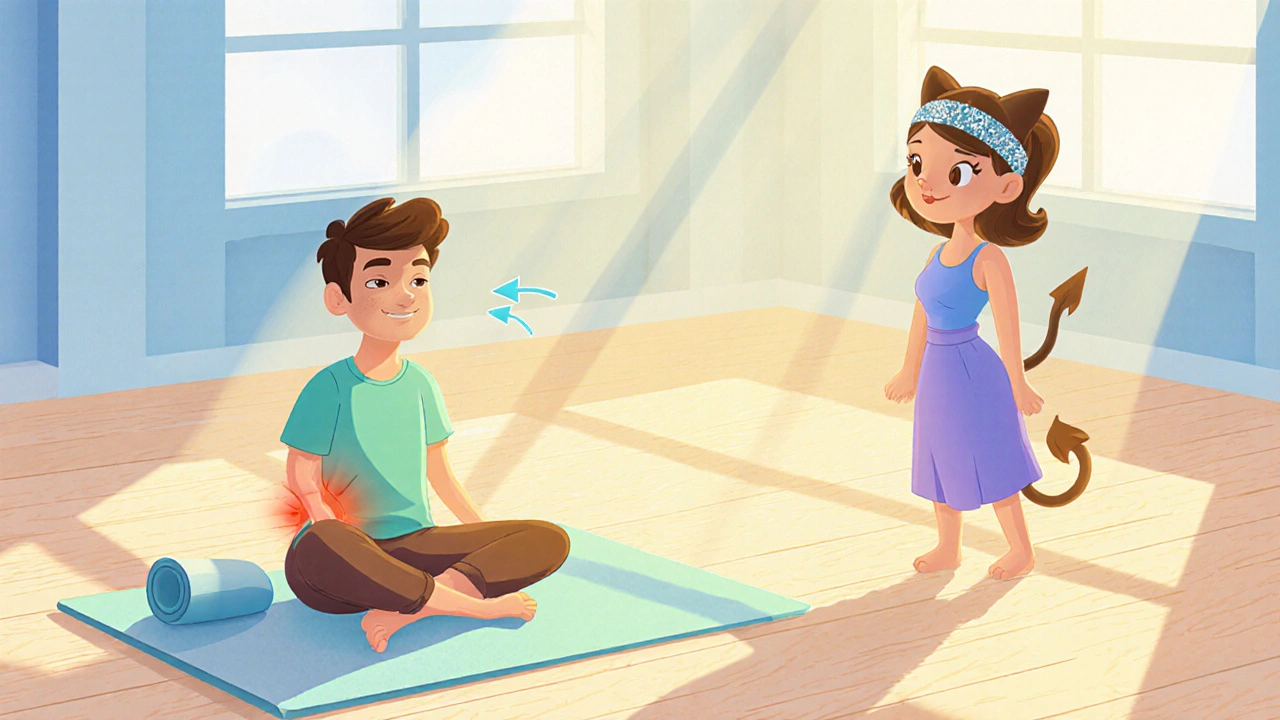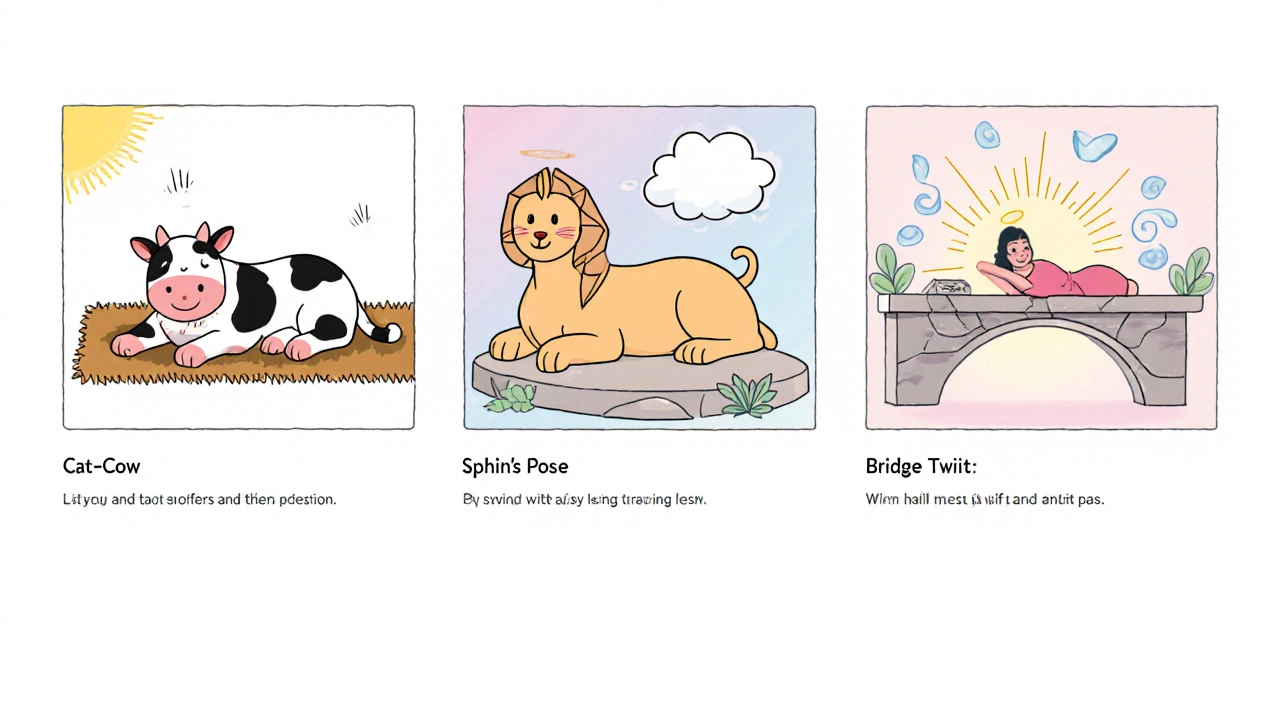 Oct, 16 2025
Oct, 16 2025
When it’s back pain that keeps you from moving, Yoga a mind‑body discipline using postures, breath, and meditation can be a game‑changer. The practice strengthens the muscles that support the Spine, improves flexibility, and lowers stress-three key drivers of chronic ache. Below is a step‑by‑step guide that shows how you can turn a simple yoga routine into lasting back‑ache relief and even prevention.
How Yoga Affects Back Health
Yoga works on three layers of the back: the bony Spine, the surrounding muscles (often called the Posterior Chain), and the nervous system that regulates pain. Gentle movement lubricates the intervertebral discs, while breath‑linked stretches trigger the parasympathetic response, cutting inflammation and stress hormones. Over time, consistent practice rebuilds core stability, improves posture, and reduces the odds of future strain.
Top Yoga Poses for Backache Relief
Each pose below targets a specific area of the back. Perform them on a mat, keep your breath steady, and never push into pain.
- Cat‑Cow Pose (Marjaryasana‑Bitilasana): Mobilises the entire spine, warming up the discs and relieving stiffness.
- How to do it: Start on all fours, inhale to arch (Cow), exhale to round (Cat). Aim for 8‑10 cycles.
- Benefit: Enhances spinal flexibility and reduces tension in the lumbar region.
- Microdata: Cat‑Cow Pose A dynamic spine‑flexion sequence that alternates arching and rounding of the back
- Child’s Pose (Balasana): Lengthens the lower back and promotes relaxation.
- How to do it: Kneel, sit back on heels, stretch arms forward, forehead to mat. Hold for 30‑60 seconds.
- Benefit: Gently decompresses the lumbar vertebrae and calms the nervous system.
- Microdata: Child’s Pose A resting posture that stretches the hips, thighs, and lower back
- Sphinx Pose (Salamba Bhujangasana): Strengthens the mid‑back without over‑arching the lower spine.
- How to do it: Lie prone, forearms on the floor, elbows under shoulders, lift chest. Hold 1‑2 minutes.
- Benefit: Builds endurance in the erector spinae and improves thoracic mobility.
- Microdata: Sphinx Pose A gentle backbend that activates the spinal extensors while keeping the lower back safe
- Bridge Pose (Setu Bandhasana): Opens the front body and activates the glutes, key for pelvic stability.
- How to do it: Lie on your back, knees bent, feet hip‑width, lift hips toward the ceiling. Hold 30‑45 seconds.
- Benefit: Strengthens the core and posterior chain, reducing load on the lumbar discs.
- Microdata: Bridge Pose A supine backbend that engages the glutes, hamstrings, and lower back muscles
- Supine Twist (Supta Matsyendrasana): Releases tension in the lower back and improves spinal rotation.
Quick Pose Comparison Table
| Pose | Target Area | Recommended Hold | Difficulty |
|---|---|---|---|
| Cat‑Cow | Entire spine | 8‑10 cycles | Easy |
| Child’s Pose | Lower back | 30‑60s | Easy |
| Sphinx Pose | Mid‑back | 1‑2min | Moderate |
| Bridge Pose | Lower back & glutes | 30‑45s | Moderate |
| Supine Twist | Lower back & hips | 30‑45s per side | Easy‑Moderate |

Building a Home Routine
- Start with a 5‑minute warm‑up (gentle walking or marching in place).
- Move through the five poses in the order listed, keeping breath smooth.
- End with 2‑3 minutes of seated meditation or diaphragmatic breathing to seal the session.
Do this routine 3‑4 times a week. As you gain confidence, extend the hold times or add variations like Core Strength drills (e.g., plank) to further protect the spine.
When to See a Professional
If any movement causes sharp or radiating pain, stop immediately and consult a healthcare provider. Specific red flags include:
- Sudden loss of bladder or bowel control.
- Numbness extending down the legs.
- Persistent pain lasting more than two weeks despite gentle yoga.
Physiotherapists can tailor a program that blends yoga with targeted strengthening, ensuring you stay safe while you recover.

Back‑Care Checklist
- Practice the routine at least three times weekly.
- Maintain a neutral spine during daily activities (e.g., computer work).
- Stay hydrated - discs need water to stay supple.
- Combine yoga with short, frequent walks to keep blood flowing.
- Track pain levels in a journal; note which poses provide the most relief.
Frequently Asked Questions
Can yoga replace physical therapy for chronic back pain?
Yoga is a great complementary tool, but it isn’t a full substitute for professional physiotherapy when structural issues exist. Use yoga to boost flexibility and core strength while following a therapist’s rehab plan.
How long before I feel relief?
Most people notice reduced stiffness after 1‑2 weeks of consistent practice. Significant pain reduction may take 4‑6 weeks, especially if you combine yoga with ergonomic changes.
Are there poses I should avoid?
If you have a herniated disc, stay away from deep forward bends like full‑pike or intense backbends such as Wheel Pose. Stick to gentle, spinal‑neutral moves until cleared by a clinician.
Do I need special equipment?
A decent yoga mat and a small block or rolled towel are enough. The block helps modify poses like Bridge or Sphinx if your hamstrings feel tight.
Can beginners still get the same benefits?
Absolutely. The key is consistency and listening to your body. Start with the easy versions of each pose and gradually increase duration as your back feels stronger.
If you’re ready to try a low‑impact solution that tackles pain at its source, give Yoga for back pain a regular slot in your week. The combination of movement, breath, and mindfulness can transform a stubborn ache into a resilient, healthier back.

Malia Rivera
October 16, 2025 AT 21:01Yoga isn’t just a workout; it’s a philosophy that asks us to respect the vessel that carries our thoughts. By aligning breath with movement we give the spine a chance to breathe too, and that’s something our nation’s strong backs need. The Cat‑Cow flow is like a diplomatic handshake between vertebrae – gentle but purposeful. If you skip the warm‑up, you’re basically sending a hostile signal to your muscles. So treat each pose like a pledge to your own health, and you’ll feel the difference in daily life.
Kate Marr
October 18, 2025 AT 00:47Give yoga a chance, folks 🇺🇸. The Sphinx Pose is a subtle way to build a resilient spine while staying true to our American grit. No need for fancy gear, just a mat and a can‑do attitude. 🙌 Keep the breath steady and you’ll see the back pain melt away. Let’s show the world that we can be strong and flexible at the same time.
Alexis Howard
October 19, 2025 AT 04:34Everyone says yoga is the answer but that’s just hype.
Tom Green
October 20, 2025 AT 08:21Hey all, just wanted to add that if you’re new to these moves, start slow and listen to your body. The Bridge can feel intense at first, but using a block makes it accessible. Remember, consistency beats intensity – a few minutes each day builds real strength. If you ever feel a twinge, pause and breathe; the practice is about healing, not pushing. We’re all in this together, so keep encouraging each other!
Emily Rankin
October 21, 2025 AT 12:07Imagine a spine that sings, each vertebra a note in a grand symphony of movement. The Cat‑Cow becomes a dance, a dialogue between the earth and the heavens, urging the back to remember its ancient fluidity. In Child’s Pose, we surrender to gravity, letting the weight of the world melt into the mat, and the nervous system sighs in relief. The Sphinx, with its regal poise, awakens the middle back, coaxing the ribs to expand like sunrise over a calm sea. Bridge Pose lifts us, both literally and metaphorically, reminding us that we can rise above static pain. Each breath is a tide, pulling tension out and flooding the cells with oxygenated life. When we twist in Supine Twist, we untangle the knots of daily stress, allowing the spinal discs to glide smoothly. Over weeks, this ritual becomes a pilgrimage, a pilgrimage not just of the body but of the spirit, where every stretch is a prayer for freedom. The consistency of practice mirrors the constancy of the stars, and the back, once a burden, transforms into a pillar of strength. By tracking our pain levels, we become the cartographers of our own health, mapping progress with each session. Hydration, the silent partner, keeps the discs supple, much like rain to a thirsty root. Short walks between sessions keep the blood circulating, delivering nutrients as messengers of repair. The mindfulness that crowns this practice reminds us that pain is not a foe but a teacher, urging us toward awareness. In this way, yoga does not replace therapy; it complements it, weaving a tapestry of resilience. As we breathe, we stitch together muscle, bone, and mind into a cohesive whole, and the back pain that once held us captive becomes a distant echo. So let us step onto the mat with reverence, and let the ancient art of yoga rewrite the story of our backs.
Rebecca Mitchell
October 22, 2025 AT 15:54Wow that was a lot of poetic fluff, but honestly the Bridge Pose is just a hip lift. If you can’t do it, use a pillow and stop over‑thinking.
Roberta Makaravage
October 23, 2025 AT 19:41Let me set the record straight: yoga is a scientifically backed method for back pain, not just some trendy fad. The literature shows consistent practice improves core activation and reduces inflammation. So if you skip the breath work because you think it’s “woo‑woo,” you’re missing the whole point. 📚💪 Use a block, keep your spine neutral, and respect the anatomy – that’s the moral of the story. 👇
Lauren Sproule
October 24, 2025 AT 23:27hey i get where you’re coming from but just a lil reminder that not everyone has a fancy yoga studio. you can totally do these poses on a cheap mat at home. also, staying hydrated is key – water keeps those discs happy 😊
CHIRAG AGARWAL
October 26, 2025 AT 03:14Yo, I tried the Sphinx and felt like a real superhero, but then my neighbor asked if I was doing yoga in the hallway. Seriously, what’s the deal with people being so judgmental about stretching? Just because you’re on a couch doesn’t mean you can’t work your back. I’m doing the routine twice a day now and my back pain is almost gone. If anyone’s scared of the “deep stretch” thing, just start with 5 seconds and work up. Trust me, the community loves when you share your progress, so keep posting those updates!
genevieve gaudet
October 27, 2025 AT 07:01Interesting how yoga bridges ancient Eastern wisdom with modern Western health concerns. As someone who grew up hearing stories about yoga in my grandparents’ kitchen, I see this as a cultural exchange that benefits both sides. The postures like Child’s Pose feel like a gentle nod to our ancestors’ reverence for the earth. By embracing these practices, we honor a tradition while also addressing a very real, very American problem: back pain from desk jobs.
Patricia Echegaray
October 28, 2025 AT 10:47Don’t be fooled, folks. The “well‑being” agenda that pushes yoga is part of a larger scheme to control our bodies. They want us to believe that a mat and some stretching will free us, while the powers that be keep the real pain hidden behind corporate desks. I’m not saying you can’t stretch, but always question who profits from the narrative. Keep your eyes open, stay skeptical, and don’t let the “feel‑good” hype distract you from the truth.
Samantha Oldrid
October 29, 2025 AT 14:34Sure, keep reading the hype. Yoga won’t fix a broken spine. 🙄
lisa howard
October 30, 2025 AT 18:21Listen, I’ve been on this journey for months now, and let me tell you, the transformation is nothing short of a theatrical masterpiece. The moment I first attempted the Supine Twist, I felt as if a curtain was pulled back, revealing a hidden stage within my body where the drama of tension and release plays out with each breath. The Bridge Pose, when held for those glorious minutes, felt like the climax of an epic saga where the hero (my spine) finally lifts beyond the ordinary, soaring on the wings of glutes and hamstrings. The audience – my mind – watches in awe as the back muscles, once the antagonists, become allies, supporting the plot with their newfound strength. Each Cat‑Cow cycle is a tender intermission, allowing the narrative to breathe, resetting the tempo before the next act. In Child’s Pose, I find the quiet lullaby that soothes the restless chorus of nerves, a gentle lull before the next crescendo. And let’s not forget the Sphinx, that regal protagonist, standing tall, embodying poise and grace, urging the thoracic spine to embrace its royal role. Over time, this routine has turned my daily grind into a lyrical ballet, each movement choreographed by intention, each stretch an eloquent line of dialogue between body and soul. The pain that once wrote a bleak monologue now whispers a hopeful stanza, promising relief if only we listen. So, dear readers, if you crave a story that transcends the mundane, step onto your mat and become the author of your own back‑pain saga.
Cindy Thomas
October 31, 2025 AT 22:07🙂 Nice storytelling, but remember to keep the practice realistic. Too much drama can distract from the actual benefits.
James Falcone
November 2, 2025 AT 01:54Yo, this yoga thing is straight up American hustle – get strong, stay flexible, dominate the day. No time for fluff, just results.
Frank Diaz
November 3, 2025 AT 05:41While you chant about “hustle,” consider that true mastery comes from deep awareness, not shallow bragging. The spine is a temple; treat it with reverence, not as a trophy.